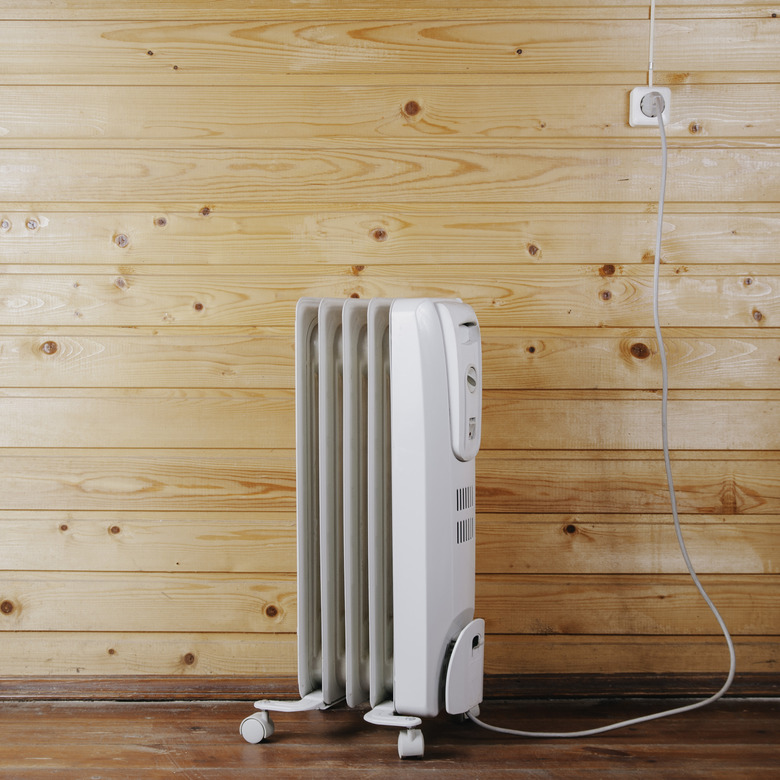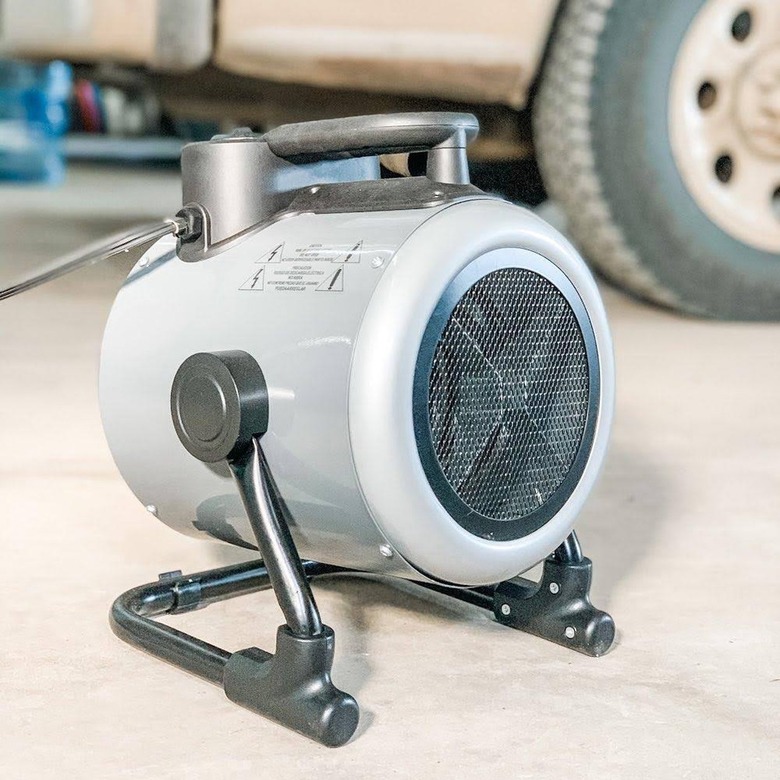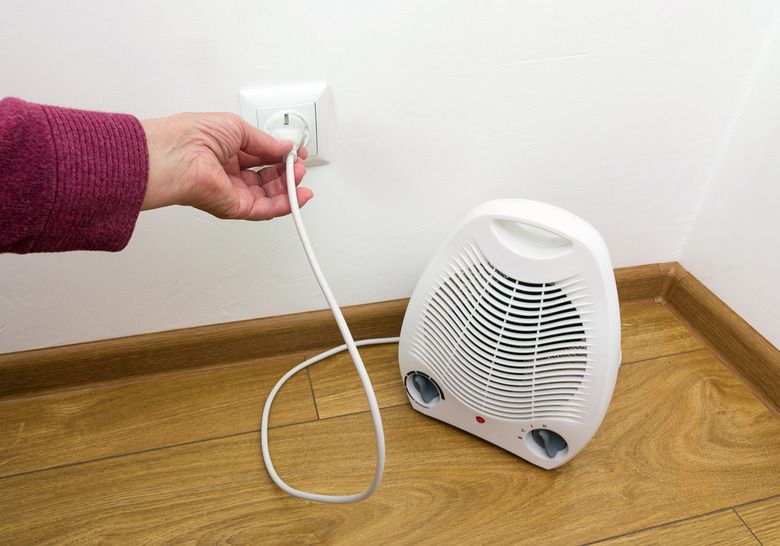How To Troubleshoot An Electric Space Heater
Of the many ways to heat your house, none is more convenient that an electric space heater, which is why these portable heaters are so ubiquitous. People use them to heat rooms and garages, to provide personal heat to keep their feet warm, and even to improve growing conditions in greenhouses. They are ideal for these and other situations because they provide instant, emission-free heat as soon as you plug them in and turn them on. They have drawbacks, the main one being the use of electricity, which is expensive and won't be an eco-friendly source of heating energy until power companies fully commit to renewable fuels, but since they are typically used for intermittent heating, the benefits of portable electric heaters usually outweigh the drawbacks.
All electric heaters deliver resistive heat, which is the heat produced by electrical resistance to current passing through a heating element. Radiant heaters are designed to allow the heat from the heating element to radiate directly into the room, while most convective heaters (not all) employ fans to circulate air heated by the element. When a space heater malfunctions, it's almost always due to a problem in the electrical circuitry, although occasionally, it's a mechanical malfunction, such as a stuck fan.
You don't have to be an electrical engineer to fix a broken space heater, but it helps to have a little electrical knowledge. People who feel that electrical repairs are completely beyond them are better off calling an electrician or bringing the heater in for service rather than trying to disassemble a space heater to fix it. Many repairs, however, don't call for disassembly, and anybody can accomplish these simple repairs safely.
Components and Operation of a Space Heater
Components and Operation of a Space Heater
The heart of an electrical space heater is the resistive heating element, which may be visible through a grille on the front of the housing, may be buried deep inside, or may be immersed in an oil-filled radiator chamber. Any heater that plugs into a household receptacle operates at 120 volts, and most heating elements draw between 4 and 12.5 amps, consuming between 400 and 1,500 watts of power. The electrical resistance of the element converts 100 percent of that power to heat, but units differ in how they distribute it.
The simplest type of electric space heater is a radiant heater, which employs a curved metal surface placed behind the element to magnify the heat and direct it into the room. Some wall-mounted panel heaters create natural convection currents to circulate heated air, like a baseboard heater, but most convection heaters employ a fan or blower that like the heating element is controlled by a thermostat mounted on the top or front of the housing. Common safety features include a limit switch to shut off the power when the unit overheats as well as a tip-over switch that shuts off the heater if the base loses even contact with the floor. The National Fire Protection Association says that from 2011 to 2015, some 43 percent of home heating fires were caused by portable space heaters, so you should buy a particular model only if it has these safety switches.
Besides these essential components, many space heaters have convenience and energy-saving features, such as a rotating tower or rotating louvers, a programmable thermostat and timer, and a low-power setting. Some units automatically switch into low-power mode when the room temperature approaches the target temperature on the thermostat. Many heater malfunctions can be caused by improper use of these functions, and normal functions can be restored by using them correctly.
Read the Manual
Read the Manual
Given the wide variety of available designs and features, it's important to familiarize yourself with your new space heater by reading the owner's manual, and you should do this before plugging it in and turning it on. Make sure you know what every button and dial is for and when to use it, and if you buy a heater with an LED display, familiarize yourself with the error codes than can appear there.
As an example of why this is important, consider a heater with a programmable timer. If you don't know how it works, you may be frustrated when your heater doesn't turn on immediately, and you might suspect some internal malfunction when all you need to do is disable the timer. Similarly, if the heater isn't warming the room sufficiently, it may be in low-power mode, and if the heater has an LED, this may be indicated by a symbol you might not recognize if you haven't read the manual.
The owner's manual is your single most valuable resource for troubleshooting heater problems. If you lost the paper copy that came with the heater, you should be able to get an electronic version of the manual on the manufacturer's website.
The Heater Won't Turn On
The Heater Won't Turn On
Failure of a space heater to turn on is one of the most common problems, and one of the most common causes is a tripped circuit breaker in the home's service panel, or breaker box. Space heaters that draw 1,500 watts of power — which is a lot — frequently overload household circuits, and if the breaker continues to trip, you either have to remove other home appliances from the circuit or plug the heater into a different circuit. A tripped GFCI outlet also cuts power to the heater circuit, so if the breaker hasn't tripped, check the receptacle where the heater is plugged in and reset it if necessary. If that receptacle hasn't tripped, look for another one in the house that has. Even if it's in another room or even outside, it could be on the same circuit, and resetting it may restore power to the heater.
You can always test a receptacle to see if it works by plugging in another appliance, and if the appliance powers on, you'll know you can look elsewhere for the problem. For example, the loss of power in the heater may be due to an electrical problem in the power cord or in the heater itself. Check the cord for damage, and if you're using an extension cord — which isn't recommended — try switching it for another one. Be sure your extension cord is rated for more amps than the heater's amperage rating; an undersized cord is a serious fire hazard.
It's also fairly easy to remove the terminal panel cover, which may be on the back of the heater or underneath, by unscrewing a few screws with a screwdriver so you can inspect the power cord connections. Tighten them if they aren't soldered or replace the power cord (if possible) if it's damaged. You should also check the power switch to be sure it's firmly connected to the heater housing.
Servicing Safety Switches and Fuses
Servicing Safety Switches and Fuses
These days, virtually all space heaters have a high limit switch or fuse to prevent overheating and a tip-over switch. The tip-over switch is on the bottom of the unit, and it has to be in contact with the floor, so if the heater is resting on thick carpeting or it's partially propped up to direct heat higher into the room, this switch may not be depressed, so the heater gets no power. Make sure the heater is on a flat, solid surface so the button is fully depressed. On the other hand, it's possible but rare for this switch to malfunction so that it gets stuck in the depressed position (in other words, it won't retract), and since that disables the safety feature, the switch should be replaced.
Many heaters have a resettable limit switch that will switch off power when the heater overheats and then switch it back on as soon as the heater cools down, so there's no need to replace it. Some have a high limit fuse, though, and if the fuse has blown, you do need to replace it. Unplug the heater before disassembling it to access the fuse and use your owner's manual to identify it. A blown fuse typically turns black or melts, which is how you can tell it has blown. Replace it with an identical one, which you can usually purchase through an online appliance parts retailer or through the manufacturer's website.
The Heater Doesn't Get Warm
The Heater Doesn't Get Warm
If your portable heater powers up and the power light comes on but the heater is putting out insufficient heat, one or more of the heating elements may be at fault, and you can check them with a multimeter. Before you go to the trouble of disassembling the heater to access the elements, check the controls to verify that the heater isn't in eco mode or programmed to come on at a certain time or temperature. If you have a convection heater, check the fan. It may not be running, and it may need a good cleaning or a squirt with spray lubricant to loosen it.
Disassembly begins by removing screws, and there may be just a few or quite a few depending on the heater. Depending on the heater, the back of the unit may come off first followed by the top and the front, or the housing may separate into two halves. Either way, you can stop disassembly when you expose the heater element terminals. Some heaters have one element, but others have more than one, and each needs to be tested separately.
Because you shut off the unit and unplugged it before disassembly (or at least you should have), the heater doesn't have power, which is the prerequisite for testing resistance. Set a multimeter to measure ohms (Ω) of resistance, touch one lead to the element terminal and the other to ground, and note the reading. You'll probably need the manual to tell you which terminal is which. If the element is good, the reading should be 50Ω or more. If it's zero or close to zero, the element is bad and needs to be replaced.
The Heater Smells Bad
The Heater Smells Bad
Ideally, electric space heaters should be odorless, so if you smell something burning when the heater comes on, it's usually caused by dust on the element. This typically burns away after the heater has been on for a while, but if it continues, it may be due to gunk on the heating element from a spill or some other accident in the vicinity of the heater.
After gaining access to the element by removing the front grille or disassembling the heater, you can usually clean this gunk with a damp rag or one moistened with a solvent, such as alcohol. If you have a ceramic heater, be sure to clean the ceramic surrounding the elements as well as the elements themselves. Set the heater in the off position and disconnect it from the power source before cleaning. If you use a flammable solvent, give the solvent ample time to evaporate before plugging the heater back in and turning it on.
Repairing vs. Replacing a Space Heater
Repairing vs. Replacing a Space Heater
Just as you need an electrician to handle complicated electrical problems, you need a service pro to diagnose and repair the circuitry inside a space heater. If the heater has been allowed to overheat, the main control board or some of the soldered connections may have degraded, and repair might involve replacing these parts. Considering that the typical space heater costs less than $100 and that a service pro charges almost that much by the hour, you're usually better off buying a new heater if things get to that point.
References
- Just Energy: Which Energy Efficient Space Heater Is Best for You?
- Energy.gov: Portable Heaters
- All About Circuits: Teardown Tuesday: Space Heater
- Qlabe: How Do I Repair My Space Heater? Steps To Troubleshoot an Electric Heater
- Heater Tips: Can I use an Extension Cord with a Space Heater?
- NewAir: Setting Up and Troubleshooting Common Space Heater Issues


